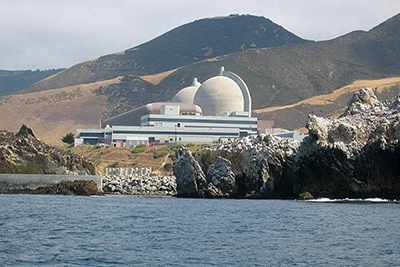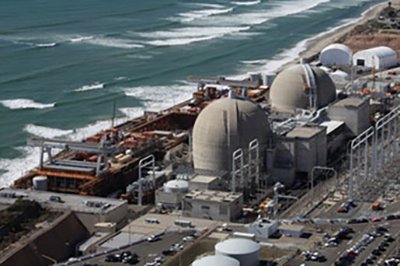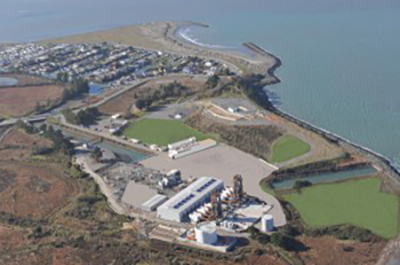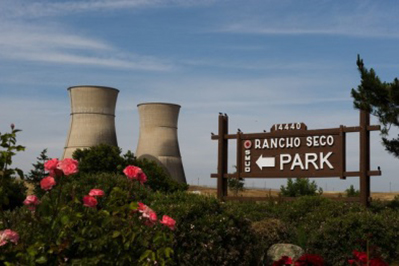Nuclear Power Preparedness Program
The Nuclear Power Preparedness (NPP) Program covers emergency planning issues related to the State’s one operating nuclear power plant – Diablo Canyon Power Plant (DCPP). The NPP program also continues coordination with one decommissioning nuclear power plant – San Onofre Nuclear Generating Station and two retired nuclear power plants – Humboldt Bay Nuclear Power Plant and Rancho Seco Nuclear Generating Station. The NPP program works with federal, state, local and utility officials in emergency planning, training and exercises to test emergency readiness. Together, through these combined preparedness efforts, the State of California provides reasonable assurance that appropriate measures can be taken to protect the health and safety of the public in the event of a radiological emergency at a nuclear power plant.
Nuclear Power Plants in California
Diablo Canyon Power Plant

Diablo Canyon Power Plant (DCPP), operated by Pacific Gas & Electric (PG&E), is located in San Luis Obispo County and has two operating units (Units 1 & 2) that are licensed until 2024 and 2025 respectively. The two units produce a total of 18,000 gigawatt hours of electricity annually. DCPP also has an Independent Spent Fuel Storage Installation with spent fuel in dry storage.
DCPP Emergency Planning Zone Map
DCPP Emergency Information for Agriculture Brochure
San Onofre Nuclear Generating Station (SONGS)

San Onofre Nuclear Generating Station (SONGS), owned by Southern California Edison (SCE) in San Diego County, had three reactors. Unit 1 was retired in 1992. Units 2 and 3 remained in operation until 2012 and in June of 2013 SCE began closing both units. In March of 2015 the NRC granted permission for SCE to begin decommissioning the site. SONGS has an Independent Spent Fuel Storage Installation with spent fuel in dry storage.
Humboldt Bay Nuclear Power Plant
 The Humboldt Bay Nuclear Power Plant near Eureka is owned by Pacific Gas & Electric (PG&E) and is the oldest commercial nuclear power plant in the state. Humboldt Bay Unit 3 was commissioned in August 1963 and operated as a 65 megawatt natural circulation boiling water reactor. Unit 3 was shut down in 1976 for refueling and seismic upgrades. Repairs subsequently extended the planned shutdown period and in that interval, there were significant changes to nuclear safety standards for reactor operations and design. Ultimately the decision was made that further modifications were not economical and that Unit 3 would not be restarted. In 1983, PG&E announced its intention to decommission Unit 3. Humboldt Bay continues the decommission process and has an Independent Spent Fuel Storage Installation with spent fuel in dry storage.
The Humboldt Bay Nuclear Power Plant near Eureka is owned by Pacific Gas & Electric (PG&E) and is the oldest commercial nuclear power plant in the state. Humboldt Bay Unit 3 was commissioned in August 1963 and operated as a 65 megawatt natural circulation boiling water reactor. Unit 3 was shut down in 1976 for refueling and seismic upgrades. Repairs subsequently extended the planned shutdown period and in that interval, there were significant changes to nuclear safety standards for reactor operations and design. Ultimately the decision was made that further modifications were not economical and that Unit 3 would not be restarted. In 1983, PG&E announced its intention to decommission Unit 3. Humboldt Bay continues the decommission process and has an Independent Spent Fuel Storage Installation with spent fuel in dry storage.
Rancho Seco Nuclear Generating Station
 Rancho Seco Nuclear Generating Station near Sacramento is owned by the Sacramento Municipal Utility District (SMUD). The Rancho Seco plant began producing electricity in 1975.
Rancho Seco Nuclear Generating Station near Sacramento is owned by the Sacramento Municipal Utility District (SMUD). The Rancho Seco plant began producing electricity in 1975.
On June 6, 1989, the residents of Sacramento County voted to shut down the plant and it was closed the next day on June 7, 1989. Rancho Seco continues with the decommissioning process and has an Independent Spent Fuel Storage Installation with spent fuel in dry storage.
Foundation and Authorities
In 1979, following the accident at Three Mile Island nuclear power plant in Pennsylvania, the California State Legislature mandated that the California Office of Emergency Services (Cal OES), together with the California Department of Public Health (CDPH) and affected counties, investigate the consequences of a serious nuclear power plant accident. Based on site-specific studies in 1980, Emergency Planning Zones (EPZ) around the plant sites were established in detail and integrated plans were developed.
Legislation mandating the NPP program has been continuous since 1979, enacted as Government Code and Health and Safety Code sections, called the Radiation Protection Act.
Emergency Response and Recovery
In the event of an emergency at one of California’s nuclear power plants, Cal OES is prepared to mobilize state resources and to request and coordinate federal resources to mitigate the effects of radiation released into the atmosphere.
While Cal OES has coordination authority during emergency response, CDPH will provide radiological assessments during all phases of such emergencies and will be the technical lead during “ingestion pathway” and “recovery” phases of an emergency. The goal during ingestion pathway response is preventing contaminated water, food and food animals from reaching the consumer. The goal during recovery is restoring areas to pre-accident conditions.
Emergency Plans: Federal regulations require nuclear power plants, states and surrounding counties have a federally tested and approved emergency response plan. The Federal Emergency Management Agency (FEMA) is responsible for ensuring adherence to emergency planning and exercise requirements by emergency response organizations outside of the power plant boundaries which is referred to as “offsite”. The Nuclear Regulatory Commission (NRC) is responsible for the regulatory application of these guidelines at the nuclear power plant which is referred to as “onsite”. Radiation releases are monitored and controlled by strict Environmental Protection Agency (EPA) guidelines to keep the public and emergency responders safe.
Emergency Notification: In the event of a nuclear power plant incident, the power plant (utility company) immediately notifies the California State Warning Center and counties in the Plume Exposure Pathway Emergency Planning Zones (EPZ). The Warning Center continues the notification process to other agencies according to procedures for NPP incidents. The power plant provides the emergency classification level (ECL) and plant information to the Warning Center for updates along the notification chain.
Emergency Classification Levels (ECL): Federal guidelines classify emergency conditions at U.S. nuclear power plants into four levels. They are listed below in order from the least to the most serious:
- Notification of Unusual Event (NOUE): Indicates a potential problem with operation of the plant. Officials are notified but no public action is needed.
- Alert: Indicates an event that could reduce the plant’s level of safety. Any release of radioactivity would be a small fraction of the federal guidelines. Designated Emergency Operations Centers and facilities may be activated. No public action is needed.
- Site Area Emergency (SAE): Indicates a problem that substantially reduces the plant’s level of safety. Release of radioactivity outside the plant site would not be expected to exceed federal guidelines. Those who live and work in the EPZ should monitor the situation on television or radio. Limited actions to protect the public may be needed.
- General Emergency (GE): Indicates a problem affecting safety systems in the plant that could lead to a release of radiation that would exceed the federal guidelines outside the plant. Warning sirens will sound. Officials may order protective action for those who live in the EPZ.
Emergency Planning Zones (EPZ) and Protective Actions
Emergency Planning Zones (EPZ): The EPZ is the area surrounding a nuclear power plant for which plans/procedures exist to ensure that prompt and effective actions occur to protect the health and safety of the public in case of an incident. FEMA recognizes two types of EPZs for planning purposes: the plume exposure pathway EPZ and the ingestion exposure pathway EPZ. Additionally California has established a third planning zone called the public education zone.
-
Plume Exposure Pathway (EPZ): The federal government requires that communities within approximately ten miles of a nuclear power plant be included in this zone. Based on site-specific studies in 1980 for CA nuclear power plants, EPZs around the nuclear plant sites was established. The DCPP Plume Exposure Pathway EPZ is approximately 18 to 22 miles from the plant. The SONGS Plume Exposure Pathway EPZ is approximately 10 to 14 mile from the plant. All residents within the EPZ annually receive instructions about emergency plans including protective action measures, evacuation routes and shelter locations.
-
Public Education Zone (PEZ): The State of California has also defined a broader area between 10 – 35 miles from a plant as Public Education Zones. Within this zone, the utility informs the public on preparedness plans. The distance from the plant, however would make evacuation unnecessary.
-
Ingestion Pathway Zone (IPZ): The federal government defines the IPZ as a geographic area, approximately 50 miles in radius surrounding a commercial nuclear power plant where exposure to radiation by ingestion of contaminated water or food might be possible. The IPZ for DCPP includes the counties of San Luis Obispo, Santa Barbara and Monterey Counties.
Protective Actions: State and local authorities will make protective action decisions for people in the Emergency Planning Zones from recommendations by the utility and field monitoring data from the local Dose Assessment Centers. Possible protective actions are:
-
Evacuate beaches, schools and people in the path of the plume
-
Shelter in homes, schools, hospitals or office buildings
Exercises
The safety of the public is of the upmost importance and Cal OES participates in exercises in the emergency planning zones around the nuclear power plants in California. Exercises are evaluated by the Federal Emergency Management Agency (FEMA) and the results are published in an after action report that is available to the public.
-
Plume Phase Exercises: Plume Phase exercises are held at least once every two years. During the Plume (Emergency) Phase exercise, the licensee, local, State and federal agencies coordinate to demonstrate reasonable assurance that they can protect the public within the Plume Exposure Pathway Emergency Planning Zone (10+ Miles) during a nuclear power plant emergency. The local jurisdictions are the lead agency responsible for Plume Phase exercises.
-
Ingestion Pathway Exercises: Ingestion Pathway exercises are required to be held at least once every 8 years in an exercise cycle. Cal OES is the lead agency responsible for an Ingestion Pathway Exercise. During the ingestion phase, the licensee, county and state health physicists will work together in the State Dose Assessment Center (SDAC) to recommend public protective actions, such as relocation, reentry, return and ingestion issues.
-
Congregate Care and Decontamination Drills: Congregate Care and Decontamination Center drills are conducted for each designated center at least once every 8 years during the exercise cycle. These drills are held to assess the level of local and State preparedness for receiving evacuees after a radiological event.
-
Medical Services Drills: Medical Services Drills are conducted annually. These drills are held to assess readiness in the hospital setting.
The current 8 year exercise cycle began in 2022. In addition to the exercises listed above, nuclear plants and local jurisdictions conduct numerous self-evaluated drills throughout the year.
NEW!! Just-in-Time Training Resources
To turn closed captions on or off, click on the cc icon located on the controller bar located at the bottom right side of the video player.
Resources
Federal Government
-
- Nuclear Regulatory Commission (NRC) Power Reactor Status Report
- NRC Event Notification Reports
- NRC After Action Reports
- NRC Decommissioning Fact Sheets
- Federal Emergency Management Agency (FEMA) Radiological Emergency Preparedness Program
- FEMA Nuclear Power Plants
- U.S. Department of Energy (DOE) National Nuclear Security Administration Emergency Response
- U.S. Environmental Protection Agency (EPA) Radiation Protection
- Nuclear Energy Institute
- Center for Disease Control and Prevention (CDC) Radiation Emergencies
- CDC Potassium Iodide (KI)
Paul Dumetz
Program Manager I, Radiological Preparedness Unit
Office: (916) 845-8190
Email: Paul.Dumetz@CalOES.ca.gov
